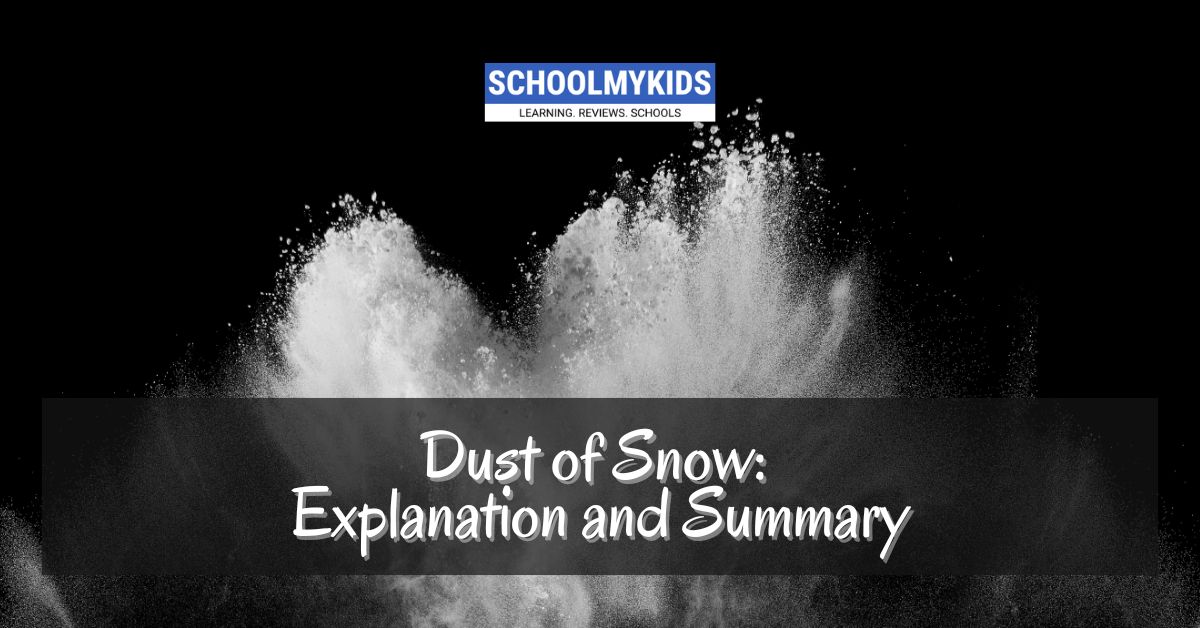“Dust of Snow” is a poem from the Class 10 CBSE English textbook, “First Flight.”
Summary
Robert Frost’s poem “Dust of Snow” is a short and powerful work that explores the transformative power of nature, particularly its ability to shift one’s perspective and improve a bad mood.
The poem opens with the speaker in a negative state of mind. The specific reason for his negativity remains unsaid, but it’s clear he’s feeling down.
Suddenly, a seemingly insignificant event changes everything. A crow shakes snow from a hemlock tree, and a bit of dust falls on the speaker. This simple act of nature has a profound effect.
Explanation of the Transformation
- Shifting Perspective: The dust of snow, a small and unexpected event, disrupts the speaker’s focus on his troubles. It takes his mind off his negativity and allows him to see the world with fresh eyes.
- Nature’s Healing Power: The poem suggests that nature has the ability to heal and uplift the human spirit. The unexpected touch of snow acts as a cleansing agent, washing away the speaker’s negativity.
- Appreciating the Little Things: The poem emphasizes the importance of appreciating the small things in life. The speaker’s change in mood is triggered by a seemingly insignificant event, highlighting the power of finding joy in simple moments.
- Symbolism: The dust of snow can be interpreted as a symbol of hope and renewal. It represents a chance to start fresh and leave behind negativity. The crow, often associated with bad omens, becomes an unlikely agent of positive change in this poem.
Theme
The central theme of “Dust of Snow” is the transformative power of nature, particularly its ability to uplift the human spirit and offer a fresh perspective. Even a tiny, unexpected encounter with nature can have a profound impact on our mood and outlook.
Overall, “Dust of Snow” is a testament to the simple joys found in nature and its potential to bring about positive change, even in the face of negativity.
10 Questions & answers
- What is the emotional state of the speaker at the beginning of “Dust of Snow”?
- Answer: The speaker is in a negative state of mind, though the specific reason remains unsaid.
- What specific event triggers a change in the speaker’s mood?
- Answer: A crow shakes snow from a hemlock tree, and a bit of dust falls on the speaker.
- How does the poem portray the transformative power of nature?
- Answer: The seemingly insignificant event of dust falling on the speaker disrupts his negativity and allows him to see the world with fresh eyes.
- What is the significance of the dust of snow in the poem?
- Answer: The dust of snow can be seen as a symbol of hope and renewal, offering the speaker a chance to start fresh.
- How does the crow, often associated with negativity, contribute to the poem’s message?
- Answer: The crow becomes an unexpected agent of positive change, highlighting the potential for even seemingly bad things to bring about good outcomes.
- What is the main theme explored in “Dust of Snow”?
- Answer: The central theme is the transformative power of nature, particularly its ability to uplift the human spirit and offer a new perspective.
- Does the poem explain why the speaker was feeling down initially?
- Answer: No, the poem leaves the reason for the speaker’s negativity ambiguous.
- What kind of language is used in the poem?
- Answer: The poem uses simple and clear language, but the imagery is powerful and evocative.
- Is “Dust of Snow” a long poem?
- Answer: No, it’s a very short poem with only four lines.
- What is the tone of the poem at the end?
- Answer: The tone shifts from negativity to one that is hopeful and suggestive of a renewed outlook.









Be the first one to comment on this story.